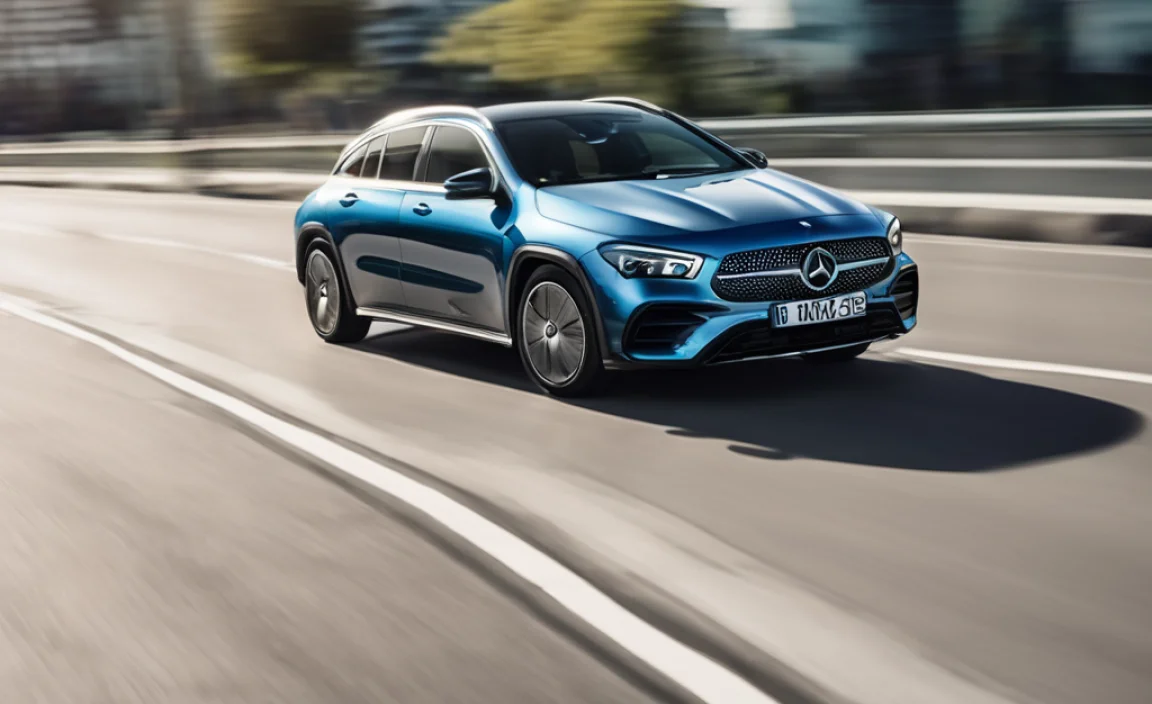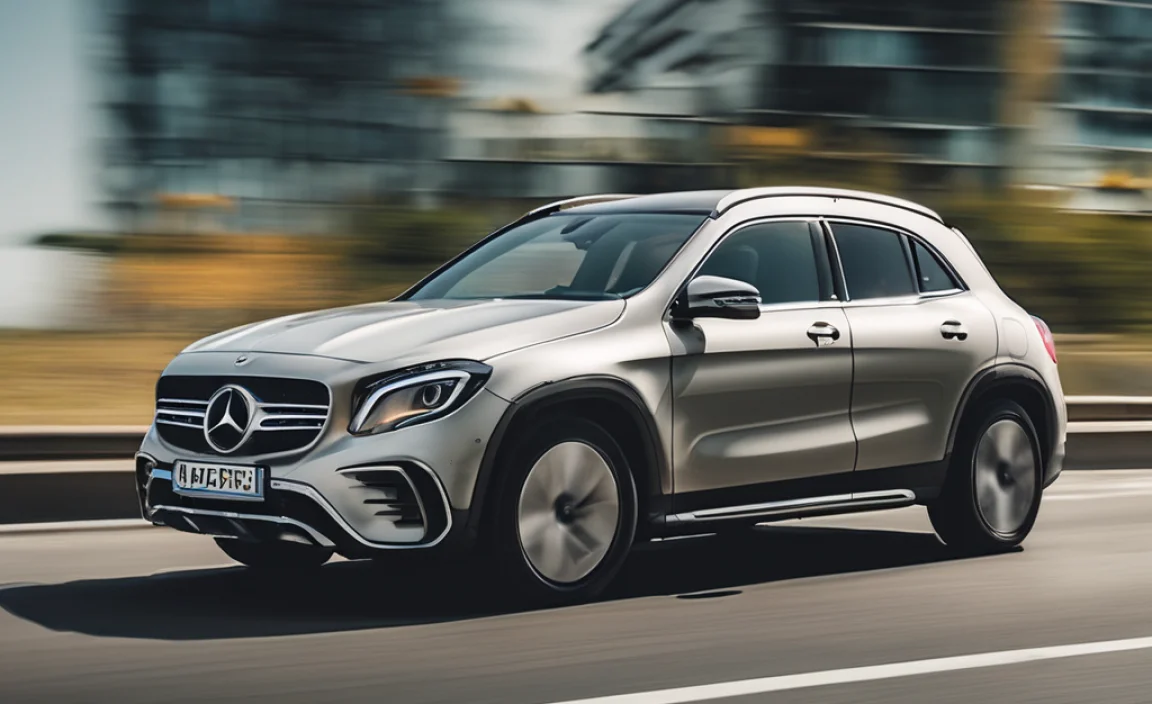GLA-Class Hybrid vs Petrol: Which is Right for You?
Choosing between a GLA-Class hybrid and a petrol model can feel like a big decision, but it doesn’t have to be complicated. This guide breaks down the differences simply. We’ll look at fuel efficiency, running costs, performance, and environmental impact to help you make the smart choice for your driving needs. Get ready to understand your GLA-Class options clearly!
GLA-Class Hybrid vs Petrol: Making the Smart Choice

Hello there, fellow Mercedes-Benz enthusiasts! Charlie Joyce here. If you’re eyeing up a stylish GLA-Class and wondering whether to go with the modern hybrid technology or stick with the tried-and-true petrol engine, you’ve come to the right place. It’s a common question, and honestly, there’s no single “best” answer. It all depends on how and where you drive, your priorities for cost savings, and what kind of driving experience you’re after. We’re going to go through everything you need to know, step-by-step, to help you feel totally confident in whichever GLA-Class you choose.
Mercedes-Benz has done a fantastic job of making both their hybrid and petrol powertrains efficient and enjoyable. But they do have distinct personalities and advantages. We’ll cover the nuts and bolts of fuel economy, how much you can expect to save on running costs, what the performance feels like, and even touch on the environmental side. By the end of this guide, you’ll have a much clearer picture of which GLA-Class is the perfect fit for your lifestyle.
Understanding the Technology: Hybrid vs. Petrol Explained

Before we dive into comparisons, let’s quickly understand what we’re talking about. A traditional petrol GLA-Class uses an internal combustion engine (ICE) powered by gasoline. It’s a familiar technology that’s been around for a long time, offering a straightforward and often powerful driving experience.
A hybrid GLA-Class, on the other hand, combines a petrol engine with an electric motor and a battery. This sophisticated system works together to improve efficiency. It can either use the electric motor alone (for short distances at lower speeds), use both the petrol engine and electric motor together for extra power, or charge the battery while you’re driving or braking. Think of it as getting the best of both worlds, optimized for different driving conditions.
Fuel Efficiency: The Big Question

This is often the first thing people consider when looking at hybrid cars. And for good reason! The primary benefit of a hybrid is its improved fuel economy, especially in city driving.
Petrol GLA-Class Fuel Economy
Petrol models offer respectable fuel efficiency for their class. However, they tend to consume more fuel in stop-and-go traffic. On the highway, their efficiency is generally quite good.
Average MPG for Petrol GLA-Class models can range from:
- Around 30-35 MPG (combined cycle) for standard models.
- Slightly higher for more fuel-efficient configurations.
Hybrid GLA-Class Fuel Economy
This is where the hybrid truly shines. The electric motor assists the petrol engine, and the ability to drive on electric power alone in certain situations significantly boosts MPG, particularly in urban environments. Regenerative braking also plays a key role, capturing energy that would otherwise be lost as heat.
Average MPG for Hybrid GLA-Class models can typically range from:
- Around 40-50+ MPG (combined cycle), depending on the specific hybrid system and driving style.
- Electric-only range is usually between 30-40 miles for plug-in hybrid (PHEV) variants, allowing for zero-emission commutes for many drivers.
Key takeaway: If your daily commute involves a lot of city driving with frequent stops and starts, the hybrid GLA-Class will likely be significantly more fuel-efficient.
Running Costs: Beyond the Pump

When we talk about running costs, we’re not just looking at how much you spend on fuel. We need to consider other factors like maintenance, taxes, and potential government incentives.
Petrol GLA-Class Running Costs
- Fuel: As discussed, this will be higher than a hybrid, especially for city driving.
- Maintenance: Generally simpler and potentially cheaper for routine servicing as there’s no high-voltage battery or electric motor system requiring specialized checks. However, as the vehicle ages, traditional engine components will still require upkeep.
- Taxes/Fees: Vehicle tax (like VED in the UK) is typically based on CO2 emissions, and petrol models generally have higher emissions than their hybrid counterparts, leading to potentially higher duties.
Hybrid GLA-Class Running Costs
- Fuel: Significantly lower due to better MPG, especially if you can utilize electric-only driving frequently.
- Maintenance: Routine maintenance might be slightly more complex due to the additional hybrid components. However, Mercedes-Benz has designed these systems for reliability. The regenerative braking can also mean less wear on traditional brake pads over time.
- Taxes/Fees: Often benefit from lower vehicle taxes due to lower CO2 emissions. Some regions may also offer tax credits or rebates for purchasing hybrid vehicles. For example, in the UK, plug-in hybrids often qualify for reduced VED.
- Electricity Costs: If you have a plug-in hybrid (PHEV), you’ll need to factor in the cost of electricity to charge the battery. However, charging at home, especially overnight on cheaper tariffs, is usually much more economical than filling up with petrol. For reference, you can find out more about home charging solutions and their impact on running costs from resources like the UK government’s information on plug-in vehicle grants and policies.
Summary of Running Costs: Over its lifetime, a hybrid GLA-Class can often prove more economical due to lower fuel consumption and potential tax benefits, especially if you can effectively use its electric capabilities.
Performance and Driving Experience

How does each type of GLA-Class actually feel to drive? This is where personal preference really comes into play.
Petrol GLA-Class Performance
- Responsiveness: Petrol engines offer immediate and familiar throttle response.
- Power Delivery: Smooth and consistent, with the engine sound providing a traditional driving feedback.
- Noise: You’ll hear the engine working, which some drivers prefer for the sense of connection to the machine.
Hybrid GLA-Class Performance
- Instant Torque: The electric motor provides instant torque, meaning quicker acceleration from a standstill. This can make the hybrid feel surprisingly nippy, especially off the line.
- Quiet Operation: At low speeds and when running on electric power, the hybrid is incredibly quiet and smooth. This creates a more refined and relaxing driving experience, particularly in traffic.
- Combined Power: When both the petrol engine and electric motor work together, you can get a significant boost in power, making for strong acceleration.
- Transitions: The switch between electric and petrol power is usually very smooth and nearly imperceptible in modern Mercedes-Benz hybrids.
What to expect: The hybrid offers a blend of silent electric cruising and potent combined power, providing a unique, refined driving experience. The petrol offers a more traditional, engaging engine sound and response.
Environmental Impact: A Greener Choice?
For many buyers, the environmental footprint of their vehicle is an important consideration. Hybrids generally offer a more eco-friendly option.
Petrol GLA-Class Environmental Impact
Petrol engines produce tailpipe emissions, including CO2, NOx, and particulate matter, which contribute to air pollution and climate change. While modern petrol engines are cleaner than ever, they still have a direct impact during use.
Hybrid GLA-Class Environmental Impact
Hybrids produce fewer emissions overall, especially when driven in electric-only mode. The reduced fuel consumption directly translates to lower CO2 emissions. Emissions from PHEVs can be close to zero on short journeys if powered by electricity alone. The manufacturing process for hybrid batteries does have an environmental cost, but comprehensive lifecycle analyses often show a net benefit over the vehicle’s lifespan due to reduced operational emissions. Organizations like the U.S. Environmental Protection Agency (EPA) provide detailed information on the environmental performance of different vehicle types.
Practical Considerations: Range, Refueling, and Infrastructure
Let’s look at the practicalities of owning each type of GLA-Class.
Petrol GLA-Class
- Range: Typically offer a good driving range on a full tank, often over 300-400 miles.
- Refueling: Widely available petrol stations mean quick and easy refueling.
- Infrastructure: None required beyond standard roads!
Hybrid GLA-Class
- Range: Total range (petrol + electric) is often comparable to or even better than petrol models. However, the electric-only range on PHEVs is typically between 30-40 miles.
- Refueling/Recharging: You still have a petrol tank for longer journeys. For PHEVs, you have the added step of charging the battery. This can be done at home using a standard socket (takes longer) or a dedicated wallbox charger (faster), or at public charging stations.
- Infrastructure: While petrol stations are everywhere, you’ll need access to charging points to maximize the benefits (and cost savings) of your PHEV. The availability of public charging is improving rapidly, but it’s worth checking the infrastructure in your local area and on routes you frequently travel.
GLA-Class Hybrid vs Petrol: A Direct Comparison Table
To help you visualize the differences, here’s a table summarizing the key points:
| Feature | Petrol GLA-Class | Hybrid GLA-Class |
|---|---|---|
| Fuel Efficiency | Good, but less efficient in city driving. | Excellent, especially in city/stop-start traffic. Significantly higher MPG potential. |
| Running Costs | Higher fuel costs, potentially higher taxes. Simpler, standard maintenance. | Lower fuel costs, potential tax benefits. May have slightly more complex hybrid maintenance but often less brake wear. Electricity costs for charging PHEVs. |
| Performance | Familiar, consistent power delivery. Traditional engine sound. | Instant torque from electric motor, quick acceleration. Quiet operation in EV mode. Strong combined power. |
| Environmental Impact | Higher tailpipe emissions. | Lower tailpipe emissions, especially when using electric power. More eco-friendly overall. |
| Range & Refueling | Good range, easy petrol refueling at any station. | Good total range. Petrol refueling + electric charging required for PHEVs. |
| Driving Experience | Traditional, engaging engine feel. | Refined, quiet, smooth. Blend of electric & petrol power. Noticeable instant acceleration. |
Who is the Petrol GLA-Class Best For?
The petrol GLA-Class remains an excellent choice for many drivers. It’s ideal if:
- You prioritize simplicity: The familiar technology means no need to worry about charging or electric-only driving modes.
- Your driving is predominantly longer highway journeys: While hybrids are efficient everywhere, the advantage of a petrol engine is often most pronounced on consistent-speed highway driving where its efficiency is at its peak.
- You don’t have easy access to charging: If charging at home or work isn’t feasible, a petrol model avoids the hassle.
- Initial purchase price is a significant factor: Historically, petrol models can sometimes have a lower upfront cost compared to their hybrid counterparts, although this gap is narrowing.
Who is the Hybrid GLA-Class Best For?
The hybrid GLA-Class is a fantastic option if:
- You want to save money on fuel: Especially if you do a lot of city driving or have a regular commute within the electric range.
- You’re environmentally conscious: Reducing your carbon footprint is a major benefit.
- You have access to home or workplace charging: This is key to unlocking the full potential (and cost savings) of a plug-in hybrid. Check out resources for home charging installation, like those offered by reputable electrical companies or EV charging specialists.
- You enjoy a quiet and refined driving experience: The silent electric running is a significant perk.
- You want cutting-edge technology: Hybrids represent the forefront of automotive efficiency technology.
Frequently Asked Questions (FAQ) about GLA-Class Hybrids vs. Petrol
Let’s address some common questions:
Q1: Is a GLA-Class hybrid more expensive to buy than a petrol model?
A: Typically, yes. Hybrid technology, with its additional battery and electric motor, often makes the initial purchase price higher. However, this difference is decreasing, and potential government incentives and lower running costs can offset the initial outlay over time.
Q2: Will I have range anxiety with a GLA-Class hybrid?
A: Generally, no. Plug-in hybrids (PHEVs) like those in the GLA-Class range have a petrol engine as a backup. This means you can drive them like a traditional car with no need to worry about finding a charger – the petrol engine will take over when the battery is depleted. Total range is often comparable to petrol models.
Q3: How long does the battery in a GLA-Class hybrid last?
A: Modern hybrid vehicle batteries are designed to last the lifespan of the vehicle, often 8-10 years or more, and many manufacturers offer long warranties (e.g., 8 years or 100,000 miles) on the battery pack. They are also highly durable.
Q4: Do I have to charge a GLA-Class hybrid every day?
A: For a plug-in hybrid (PHEV), you don’t have to, but to get the most benefit (fuel savings and emissions reduction), it’s highly recommended to charge it as often as possible. If you don’t charge it, it will simply run on its petrol engine, but you’ll miss out on the efficiency gains.
Q5: Is maintaining a hybrid GLA-Class more complicated or expensive?
A: Maintenance is generally similar for routine items like oil changes and tire rotations. Hybrid systems have fewer moving parts than complex internal combustion engines, which can reduce wear on some components. Mercedes-Benz designs these systems for reliability, and specialized technicians are trained to service them. Brake wear can also be reduced due to regenerative braking.
Q6: Which GLA-Class is better for the environment – hybrid or petrol?
A: The hybrid GLA-Class is generally better for the environment. It produces fewer tailpipe emissions, especially when driven using its electric-only mode. Reduced fuel consumption directly lowers its carbon footprint.
Making Your Choice: The Final Word
So, GLA-Class hybrid vs. petrol – which comes out on top? As we’ve explored, it’s not about one being definitively superior, but rather which aligns best with your individual driving habits and priorities.
The petrol GLA-Class stands as a solid, dependable choice for those who value simplicity, prefer a traditional driving feel, and primarily undertake long highway journeys without the need or desire to engage with charging infrastructure. Its operation is straightforward, and its performance is consistent.
The hybrid GLA-Class, particularly the plug-in hybrid variants, offers a compelling package for the modern driver. It excels in fuel efficiency for daily commutes, provides a quieter and often more responsive driving experience thanks to instant electric torque, and presents a more environmentally responsible option. Its advantages are maximized by those who can regularly charge their vehicle, enabling them to cover many miles emission-free, as validated by numerous studies on the benefits of electrified powertrains.
Consider your daily mileage, access to charging, local tax benefits, and your personal preference for driving dynamics. Whichever path you choose, you’re investing in a premium compact SUV that embodies Mercedes-Benz’s commitment to quality, safety, and innovation.
Ultimately, the best way to decide is to experience both! Arrange test drives of both a petrol and a hybrid GLA-Class at your local Mercedes-Benz dealership. Feel the difference, listen to the quiet hum of the electric motor, and imagine which one fits seamlessly into your everyday life. Happy driving!